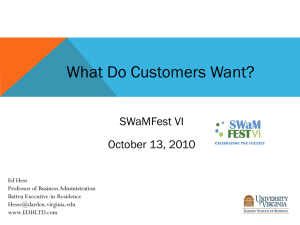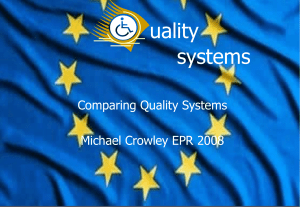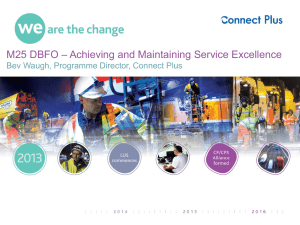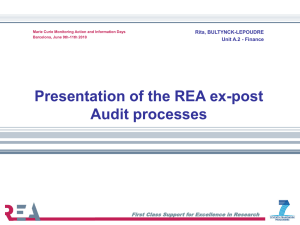Presentation 1 The Quality Movement History, approaches and
advertisement
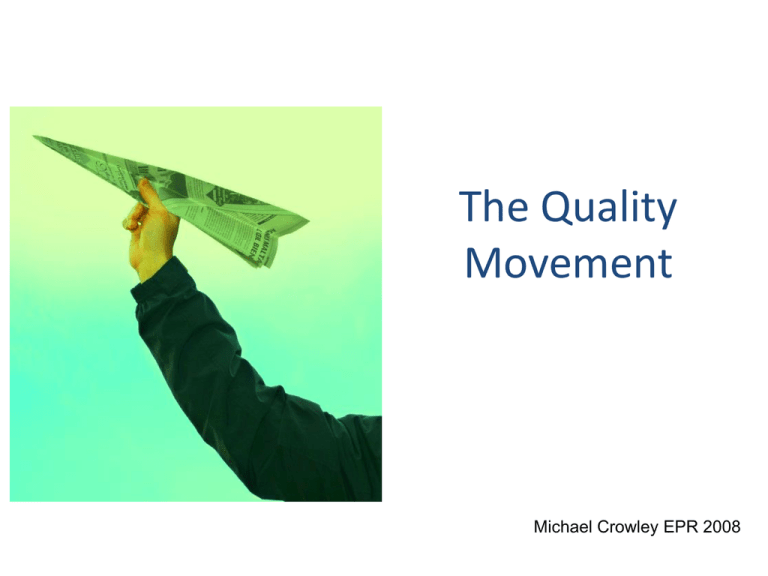
The Quality Movement Michael Crowley EPR 2008 Path Concept: Quality Historical perspective From quality to excellence The Concept Multiple dimensions Variety of phenomena Changing through time Changing with the activity sector Different from author and place Quality …. An Approach Assessment Client Warranty Planning Ethics Needs Zero defects Value Control Expectations Efficiency Effectiveness Responsibility Conformance Rights Loyalty Satisfaction Duties 2000 - ... 1990 - … - Excellence Models 1980 – Total Quality 1970 – Quality Management Programs 1960 – Quality Warranty 1930 – Statistical Control 1920 – Inspection 1900 – Supervision 1900 – Manpower predominance The century of Quality 1920 - Inspection Industrial Revolution mass production unit verification defective product Taylor's conception of work Measurement, comparison and verification activities Focus on the quantity produced 1930 – Statistical Control Sampling inspection Use of statistical tools First concerns regarding prevention: identification of causes for defective products Focus on the finished product 1930 – Statistical Control Seven Basic Quality Tools: Flowcharts and Process Maps Check lists Cause-effect diagrams Pareto diagrams Histograms Scatter diagrams Control charts 1960 – Quality Warranty First quality standards Customers’ specifications Preventive actions System’s approach Started the concern about involving everyone in the organization Focus on the manufacturing process 1970 – Quality Management Programs Evolution from the Quality Warranty phase Integration of quality on global management Quality Circles Audit Focus on the work process 1980 – Total Quality Management Principles: Responsibility delegation Staff autonomy Satisfaction of needs and expectations Struggle for improvement Adaptation needs Change management Focus on the organizational process 1980 – Total Quality Quality Management System: a set of organisational measures which transmit maximum confidence that a given quality level is being achieved with the adequate resource consumption Characteristics: External focus: at the client Global approach and as an integral component of the organization strategy Horizontal vision within the organization, from top management to staff Includes all the concerned parts Continuous learning and adaptation to change 1980 – Total Quality Tools and methodologies: Re-engineering QFD – Quality Function Deployment Benchmarking Inquiries: clients and staff Brainstorming Balanced Scorecard 1990 - ... – Excellence Models Orientation guide Flexible and adaptable instrument Self-assessment and continuous improvement models Support on the pathway to excellence Focus on customer What is Quality? • • • • • • • • Meeting specifications Meeting customer needs / expectation Transparency of service delivery Process control Achieving desired results Continuous Improvement Competitive advantage Added value for society • Best value for price • Cost effectiveness • Performance measurement • More for less • Satisfaction of stakeholders • Doing the right things • Doing things right • Doing the right things right What is Quality? Small improvements in processes Identifying and describing processes Quality control to meet specifications Quality control and financial control are divided. Customer orientation Improvement of results Improvement of management & Organisation Balanced steering of management Focus of potential customer Improvement of staff development Improvement of flexibility of the organisation Results in terms of added value for society ISO 9000: 2000 Comparison Sector Business Management Quality Management Social sector Rehabilitation Framework Guidelines Standards for QM Standards for service provision Principles of Excellence Emphasise Innovation & learning Control & assurance Control & assurance Performance improvement & learning Method Self evaluation + external audit External audit External audit Self evaluation + External audit Orientation Business Excellence Process and quality control Performance, process & quality control Excellence in service provision Recognition Europe Global Europe Europe Strategic option Flexibility Efficiency Efficiency Effectiveness The Quality Movement



